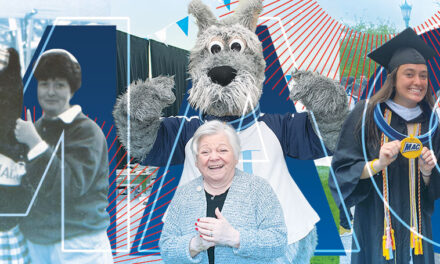by Kelly Stalker, Ed.D., exercise science professor and athletic training program director

Dr. Kelly Stalker
Millions of Americans watch college and professional sports every weekend. We find enjoyment in viewing these elite physical specimens as they compete at the highest levels of athletic performance. As weekend warriors and armchair quarterbacks, we find it easy to critique, dream and speculate as to why athletes and teams are or are not performing to the best of their abilities. We admire those individuals who can win time and time again and wonder what makes them so elite. Could it be genetics or physical biometrics, or is it their training programs?
As an athletic trainer, I have found that particular body types may provide advantages in specific sports. Michael Phelps’ success in swimming has been attributed to his extremely long wingspan and torso, which allow for fewer strokes per length of the pool. Similarly, Usain Bolt has long legs, which allow for more distance per stride. Elite gymnasts are known for their short stature that assists with power development.
Not all athletes with these physical characteristics can compete at the highest level of sports, but you will find that all elite athletes have very specific training regimens.
Understanding the amount of time that needs to be invested in training for a sport leads to the debate over participating in multiple sports or specializing in a single sport. I read a National Library of Medicine survey of over 3,000 high school, college and professional athletes and found that 67.6% of college athletes specialized in a single sport during their childhood, compared to only 46% of professional athletes. The typical age for specialization in these athletes was between 14 and 15. The report also stated that the majority of professional athletes agree that specialization will help the athletes play at a higher level, but three quarters of professional athletes would not want their children to specialize in a single sport.
Many of the best professional athletes participated in multiple sports. NFL quarterback Tom Brady played both football and baseball in college. He did not have a starting role on his collegiate football team until his junior year. Basketball player LeBron James was a high school football standout prior to focusing solely on his NBA career. Each player on the 2015 United States Women’s Soccer team was a multi-sport athlete and attributes their participation in other sports to their success on the soccer pitch. However, others like Tiger Woods and Serena and Venus Williams have had their early success in a single sport chronicled throughout the media. These mixed messages leave parents confused as to what is best for their children.
In my career, I see that early specialization can lead to decreased mental health, less time spent with friends, sacrifices of academics, increased pressure to perform, decreased enjoyment and an increased risk of injury. While this can be true of any athlete who has a full training schedule, participation in multiple sports has shown to benefit neuromuscular coordination and overall athletic development, while reducing the risk for injury. The National Athletic Trainers’ Association recommends delaying specializing in a single sport as long as possible, participating in one sport at a time with a period of rest from any sport participation, participating in the primary sport for less than eight months of the year, and participating in the sport for no more hours per week than the athlete’s age in years. We encourage our athletic training students to share these recommendations with families at their clinical sites.
Parents want what is best for their child. Societal norms have families feeling they must seize every opportunity for their child to participate in sports if they want to be successful. Unfortunately, without proper rest and recovery, sport specialization often leads to burnout and injury. Whether children participate in multiple sports or specialize in a single sport, as a society, we must realize that only a small percentage of these individuals will earn athletic scholarships and even fewer will make it to the Olympic or professional level. The physical and psychological well-being of each athlete needs to be our top priority.







